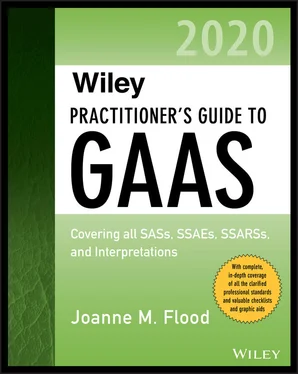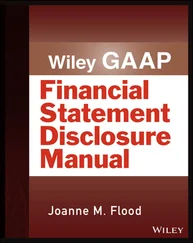2 There is ineffective monitoring of management as a result of the following:Domination of management by a single person or small group (in a nonowner-managed business) without compensating controls.Ineffective board of directors or audit committee oversight over the financial reporting process and internal control.
3 There is a complex or unstable organizational structure, as evidenced by the following:Difficulty in determining the organization or individuals who have controlling interest in the entity.Overly complex organizational structure involving unusual legal entities or managerial lines of authority.High turnover of senior management, counsel, or board members.
4 Internal control components are deficient as a result of the following:Inadequate monitoring of controls, including automated controls and controls over interim financial reporting (where external reporting is required).High turnover rates or employment of ineffective accounting, internal audit, or information technology staff.Ineffective accounting and information systems, including situations involving reportable conditions.Weak controls over budget preparation and development and compliance with law or regulation.
Attitudes/Rationalizations
Risk factors reflective of attitudes/rationalizations by board members, management, or employees that allow them to engage in and/or justify fraudulent financial reporting may not be susceptible to observation by the auditor. Nevertheless, the auditor who becomes aware of the existence of such information should consider it in identifying the risks of material misstatement arising from fraudulent financial reporting. For example, auditors may become aware of the following information that may indicate a risk factor:
Ineffective communication, implementation, support, or enforcement of the entity’s values or ethical standards by management or the communication of inappropriate values or ethical standards.
Nonfinancial management’s excessive participation in or preoccupation with the selection of accounting principles or the determination of significant estimates.
Known history of violations of securities laws or other laws and regulations, or claims against the entity, its senior management, or board members alleging fraud or violations of laws and regulations.
Excessive interest by management in maintaining or increasing the entity’s stock price or earnings trend.
A practice by management of committing analysts, creditors, and other third parties to achieve aggressive or unrealistic forecasts.
Management failing to correct known reportable conditions on a timely basis.
An interest by management in employing inappropriate means to minimize reported earnings for tax-motivated reasons.
Low morale among senior management.
The owner-manager making no distinction between personal and business transactions.
Dispute between shareholders in a closely held entity.
Recurring attempts by management to justify marginal or inappropriate accounting on the basis of materiality.
Strained relationship between management and the current or predecessor auditor, as exhibited by the following:Frequent disputes with the current or predecessor auditor on accounting, auditing, or reporting matters.Unreasonable demands on the auditor, such as unreasonable time constraints regarding the completion of the audit or the issuance of the auditor’s report.Restrictions on the auditor that inappropriately limit access to people or information or the ability to communicate effectively with the board of directors or audit committee.Domineering management behavior in dealing with the auditor involving attempts to influence the scope of the auditor’s work or the selection or continuance of personnel assigned to or consulted on the audit engagement.
Illustration 2. Risk Factors—Misappropriation of Assets
The following are examples of risk factors, reproduced with permission from AU-C Section 240, Appendix A, relating to misstatements arising from misappropriation of assets:
1 Personal financial obligations may create pressure on management or employees with access to cash or other assets susceptible to theft to misappropriate those assets.
2 Adverse relationships between the entity and employees with access to cash or other assets susceptible to theft may motivate those employees to misappropriate those assets. For example, adverse relationships may be created by the following:Known or anticipated future employee layoffs.Recent or anticipated changes to employee compensation or benefit plans.Promotions, compensation, or other rewards inconsistent with expectations.
1 Certain characteristics or circumstances may increase the susceptibility of assets to misappropriation. For example, opportunities to misappropriate assets increase when there are the following:Large amounts of cash on hand or processed.Inventory items that are small in size, of high value, or in high demand.Easily convertible assets, such as bearer bonds, diamonds, or computer chips.Fixed assets that are small in size, marketable, or lacking observable identification of ownership.
2 Inadequate internal control over assets may increase the susceptibility of misappropriation of those assets. For example, the misappropriation of assets may occur because there is the following:Inadequate segregation of duties or independent checks.Inadequate oversight of senior management expenditures, such as travel and other disbursements.Inadequate management oversight of employees responsible for assets; for example, inadequate supervision or monitoring of remote locations.Inadequate job applicant screening of employees with access to assets.Inadequate record keeping with respect to assets.Inadequate system of authorization and approval of transactions (for example, in purchasing).Inadequate physical safeguards over cash, investments, inventory, or fixed assets.Lack of complete and timely reconciliations of assets.Lack of timely and appropriate documentation of transactions, for example, credits for merchandise returns.Lack of mandatory vacations for employees performing key control functions.Inadequate management understanding of information technology, which enables information technology employees to perpetrate a misappropriation.Inadequate access controls over automated records, including controls over and review of computer systems events logs.
Attitudes/Rationalizations
Risk factors reflective of employee attitudes/rationalizations that allow them to justify misappropriation of assets are generally not susceptible to observation by the auditor. Nevertheless, the auditor who becomes aware of the existence of such information should consider it in identifying the risks of material misstatement arising from misappropriation of assets. For example, auditors may become aware of the following attitudes or behavior of employees who have access to assets susceptible to misappropriation:
Disregard for the need for monitoring or reducing risks related to misappropriation of assets.
Disregard for internal control over misappropriation of assets by overriding existing controls or by failing to correct known internal control deficiencies.
Behavior indicating displeasure or dissatisfaction with the company or its treatment of the employee.
Changes in behavior or lifestyle that may indicate assets have been misappropriated.
The belief by some government or other officials that their level of authority justifies a certain level of compensation and personal privileges.
Tolerance of petty theft.
Illustration 3. Worksheet to Identify Fraudulent Entries or Adjustments (Adapted from Au-C 240.49)
Читать дальше












